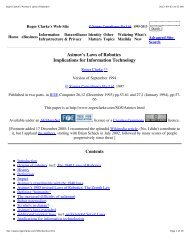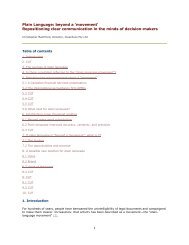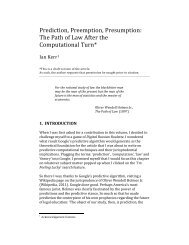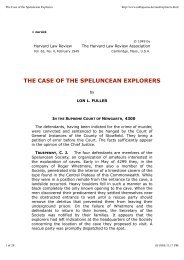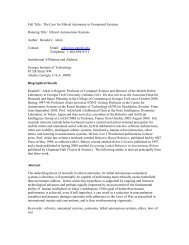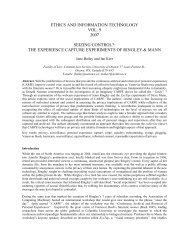Materializing Morality: Design Ethics and Technological Mediation.
Materializing Morality: Design Ethics and Technological Mediation.
Materializing Morality: Design Ethics and Technological Mediation.
You also want an ePaper? Increase the reach of your titles
YUMPU automatically turns print PDFs into web optimized ePapers that Google loves.
Verbeek / <strong>Materializing</strong> <strong>Morality</strong> 363<br />
article, I investigate how the concept can be deployed in a normative<br />
setting. To cover all relevant aspects of the role of technological artifacts in<br />
their use contexts <strong>and</strong> to provide a vocabulary for describing these aspects,<br />
I will first develop the notion of technological mediation <strong>and</strong> show that<br />
scripts can be seen as a specific aspect of mediation. After this, I will investigate<br />
how the concept of mediation can be made fruitful for design ethics.<br />
The concept provides designers with an explicit link with the use context in<br />
which their products will be functioning, making it possible to identify <strong>and</strong><br />
answer new normative questions during the design process.<br />
Integrating mediation in engineering ethics is a complex task, however.<br />
First, the ambition to design technologies with the explicit aim to influence<br />
human actions raises moral questions itself. It is not self-evident, after all, that<br />
all attempts to steer human behavior are morally justified, <strong>and</strong> steering human<br />
beings with the help of technology raises associations with the totalitarian<br />
technocracy of Orwell’s Big Brother. Second, if some forms of behaviorsteering<br />
technologies can be seen as morally acceptable—<strong>and</strong> I think such<br />
technologies do exist—it is very complicated to design them since there is no<br />
linear connection between the activities of designers <strong>and</strong> the mediating role<br />
of the artifacts they are designing. As I will make clear, this mediating role<br />
also depends on the unpredictable ways in which the technologies are used.<br />
For this reason, I will suggest two ways to cope with this unpredictability.<br />
<strong>Technological</strong> <strong>Mediation</strong> 1<br />
For analyzing the role of technologies in the daily lives of human beings,<br />
the concept of technological mediation is a helpful tool, especially in the<br />
way it was developed in postphenomenological philosophy of technology<br />
(cf. Verbeek 2005). Phenomenology—in my elementary definition—is the<br />
philosophical analysis of the structure of the relations between humans <strong>and</strong><br />
their life-world. From such a phenomenological perspective, the influence<br />
of technology on human behavior can be analyzed systematically, in terms<br />
of the role technology plays in human-world relations. <strong>Technological</strong> mediation<br />
then concerns the role of technology in human action (conceived as<br />
the ways in which human beings are present in their world) <strong>and</strong> human<br />
experience (conceived as the ways in which their world is present to them).<br />
Human-Technology Relationships<br />
A good starting point for underst<strong>and</strong>ing technological mediation is<br />
Martin Heidegger’s (1927) classical analysis of the role of tools in the<br />
Downloaded from sth.sagepub.com at QUEENS UNIV LIBRARIES on November 30, 2011



